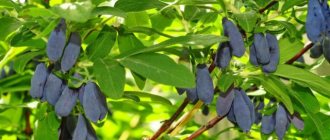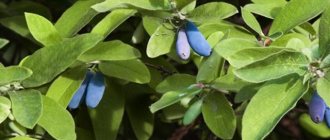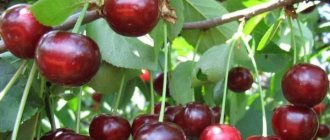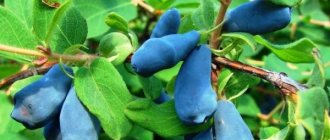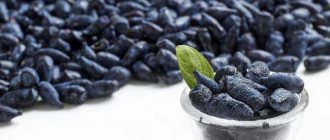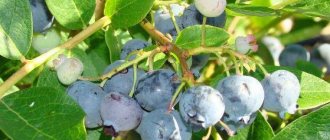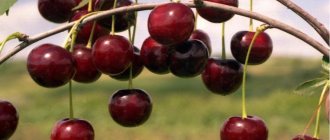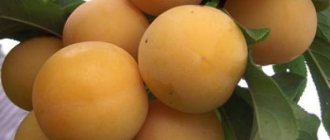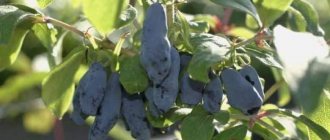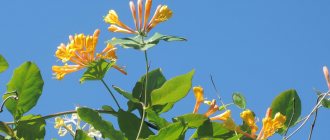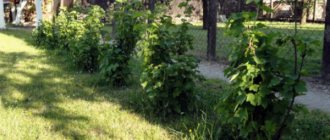Characteristics, description
Slastena is a low-growing shrub up to 1 m high. The crown is spreading and rounded. The branches are strong, covered with brown bark, and densely leafy. The leaves are bright green, with pubescence. The berries are not very large, ripen with an average weight of 1.15 g. The shape of the fruit is cylindrical. The peel is bright blue, covered with a thick waxy coating. The pulp is moderately dense. The taste is sweet, aromatic.
Advantages and disadvantages
- The Slastena variety has a list of advantages, including:
- high taste qualities;
- compactness of the bush;
- frost resistance;
- high productivity;
- resistance to diseases and pests;
- unpretentiousness.
- Gardeners call the disadvantages:
- requirement for moisture;
- small fruit size.
Frost resistance and drought resistance
Slastena is a frost-resistant crop. The plant can withstand frosts down to -45°C. It can withstand drought, but only for a short time. Honeysuckle is a moisture-loving crop and responds well to watering.
Fruiting, productivity
To set the fruits of Slastena's honeysuckle, it is necessary to plant pollinating bushes at a distance of 1–1.5 m.
Find out why edible honeysuckle does not bear fruit.
The following varieties are best suited for this role:
- Amphora;
- Nymph;
- Violet.
Harvest ripening dates are early. The fruits are filled from June 1 to June 20. You can remove up to 4 kg of fruit from a bush.
What does Malvina honeysuckle look like and what are its characteristics?
Honeysuckle Malvina was bred in the city of St. Petersburg by breeders M. Plekhanova and A. Kondrikova by crossing an elite variety number 21-5, originally from the Primorsky Territory, with honeysuckle Leningradsky Velikan. The hybrid was registered in the State Register in 2002. Designed for cultivation throughout Russia.
Description of the plant
Malvina bushes not only produce delicious berries. They are decorative and will decorate any dacha or garden plot:
- hybrid plants are characterized by tall growth and large size. The bush reaches a height of 1.5 meters;
- thin, straight green shoots and strong branches, painted brown, are abundantly covered with dense and large oval-shaped leaves with pointed ends. The leaves are dark green, smooth, without jagged edges;
- the bushes have a dense, squat crown of a round or oval shape;
- the flowers are small pale yellow bells. Inflorescences are bunch-shaped;
- plants begin to bloom immediately after the snow melts;
- honeysuckle Malvina requires other varieties of crops for pollination, which include Morena, Malvina, Start, Blue Bird or Blue Spindle;
- bushes grow slowly. Only after 4 years the plant grows up to 1 meter tall. Honeysuckle begins to bear fruit 3-4 years after planting;
- Bushes live for 25 years or more.
Description of berries
The fruits of the hybrid grow quite large for this crop:
- The length of the berry is about 3 cm, the width is no more than 1.2 cm. The weight of the berry is about 1 g;
- the fruits have an elongated, slightly tuberous shape and a bluish-blue color with a bluish waxy coating;
- The fibrous, delicate pulp is covered with a dense skin. The aroma of berries is weak;
- the taste is very pleasant, sweet and sour without bitterness.
Taste qualities are rated 4.4 points on a five-point scale.
Valuable properties of honeysuckle
The fruits of the Malvina hybrid are not only very tasty, but also very healthy. They are used in alternative medicine to treat a range of diseases. The benefits of berries are due to their incredibly rich chemical composition. 100 g of fruit pulp contains:
- sugar - about 15%;
- acids - no more than 1.9%;
- vitamin C - up to 52 mg;
- dry matter - 17.3%.
In addition, honeysuckle is rich in:
- vitamins A, group B, PP;
- malic, succinic, oxalic, citric acids;
- tannins;
- pectin;
- catechins;
- glycosides;
- micro- and macroelements - phosphorus, calcium, potassium, fluorine, sodium, magnesium, iron, copper, zinc, iodine, silicon, etc.
Honeysuckle berries increase appetite, strengthen the immune system, eliminate vitamin deficiency, and cleanse toxins. They are used for:
- diseases of the heart and blood vessels;
- diseases of the stomach and liver;
- rheumatism, gout and arthritis;
- skin diseases;
- colds and infections;
- diseases of the throat and respiratory organs;
- kidney stones and gall bladder stones.
The fruits of the plant are used to treat hypertension, diabetes, and atherosclerosis. Constant use of honeysuckle in food will improve blood composition, cleanse blood vessels of cholesterol plaques, normalize metabolism, restore vision, strengthen hair, and rejuvenate the skin.
Usage
Fresh berries are a storehouse of vitamins and other useful substances. Both adults and children love them. Jams, jellies and jams are made from honeysuckle berries. They make jelly and compote and squeeze out the juice. The fruits are dried and used to make homemade wine.
When it ripens
Malvina begins to ripen very early. Already in early June you can taste the first berries. In the middle of the month you can start harvesting. The fruits can hang on the bushes for a long time. At the same time, they will not crumble and will not lose their taste or appearance. The berries come off the stems poorly.
Yield indicators
Malvina produces high yields. From a bush over 6 years old, 1.5 to 3.5 kg of delicious berries are harvested. From one hectare - about 49 centners of fruit.
Shelf life of berries and their transportation
The berries can be stored in the refrigerator for up to 3 weeks if they are picked a few days before they are fully ripe. Fully ripe berries are stored for only 2-3 days. The Malvina variety tolerates transportation well. They can be transported over long distances with high-quality packaging. At the same time, they will not crack or wrinkle.
Weather resistance
Hybrid Malvina thrives in extreme winter temperatures. Its bushes tolerate frosts down to -50°C. The root system of plants does not freeze at -40°C, and flowering buds can withstand return frosts down to -8°C. Honeysuckle is resistant to adverse weather conditions. She does not suffer from temperature changes. The only drawback is the lack of resistance to drought and the requirement for watering. Malvina honeysuckle grows throughout our country, including in its northern regions.
Landing Features
When preparing for planting, decide on the timing and prepare the site. It is also important to choose planting material wisely. The technology of direct planting is also important - the speed of rooting of the seedling depends on it.
Deadlines
The most acceptable time for planting seedlings is September. If the root system of the seedling is closed, planting is allowed from late April to early May.
Did you know? In some varieties of honeysuckle, the bark falls off and exposes the trunk. For this property, people call them “shameless.”
Selecting a site, preparing holes
Honeysuckle, although known for being unpretentious, prefers areas with certain characteristics.
It is better to choose the area:
- open to sunlight;
- with groundwater not higher than 1.5 m to ground level;
- with loamy, soddy-podzolic or chernozem soil types;
- with neutral soil acidity.
3 days before planting, dig a hole 0.4 m wide and deep. Mix 10 kg of humus, 300 g of ash, 100 g of double superphosphate and 30 g of potassium sulfate. Pour the resulting fertile mixture into the hole. Maintain a distance of 1–1.5 m between pits. The recommended row spacing is 3 m.
Honeysuckle grows well in full sun, but can tolerate partial shade.
Selection and preparation of planting material
In order for the plant to actively develop, you need to plant a healthy seedling.
Important! It is better to buy seedlings in specialized nurseries. Licensed institutions confirm the quality of planting material with certificates.
When purchasing, pay attention to the following characteristics of planting material:
- age 2 years;
- 2–3 stems about 0.4 m tall, not higher than 1.5 m;
- branches are even, intact;
- developed roots;
- there are green buds on the shoots.
Before planting, inspect the seedling. Diseased parts with rot or plaque, if any, need to be cut off.
Planting scheme
The seedling planting scheme is as follows:
- Place the seedling in the hole.
- Carefully straighten the roots.
- Pour soil into the hole so that the root collar is 5 cm deep into the ground.
- Water the seedling.
- Mulch the tree trunk circle.
Farms specializing in breeding honeysuckle varieties
The Bakcharskoye horticultural enterprise is located in the Tomsk region. For 84 years, varieties of fruit and berry crops have been bred there. Unique, frost-resistant species are grown here. At the moment, honeysuckle is the main crop of this farm.
Her plantation covers an area of 50 hectares. Many of its varieties were created here: Bakcharsky Velikan, Tomichka, Bakcharskaya, Bakcharskaya Yubileynaya, Daughter of the Giant, Yugan and many others. Below we will consider each type in detail.
In 1926, the Pavlovsk Experimental Station of the All-Russian Research Institute of Plant Growing named after Nikolai Ivanovich Vavilov was opened near St. Petersburg. There are 4 plant research laboratories here. Employees study, grow plants, cross them and develop new species.
M. N. Plekhanova specializes in honeysuckle varieties. She and her students own the following varieties:
In addition to Russian breeders and biologists, this crop is propagated in other countries, for example, Canada and China.
Rules of care
The culture is very unpretentious. Growing bushes is not difficult at all. However, caring for the plantings is mandatory if the gardener wants to reap a rich harvest.
Important! During weeding, it is advisable to loosen the bush. However, this should be done carefully, since the rhizome grows close to the surface of the earth.
Necessary measures include watering, fertilizing, pruning and weeding:
| Watering | As the soil dries out throughout the growing season (from late April to early October). Don't let the soil dry out - Sweet tooth loves moisture. |
| Feeding | There is no need to fertilize for the first 2 years. The scheme for fertilizing shrubs from the 3rd year of life can be as follows:
|
| Trimming | In early April or mid-October, remove branches that thicken the crown. These include dry, broken and inward growing shoots. |
| Weeding | Remove weeds as they appear. |
Honeysuckle Slastena: variety description, photos, reviews, planting and care, pollinators
The popularity of honeysuckle is growing every year.
This crop is characterized by early ripening, high frost resistance and resistance to return frosts, which allows it to be grown even in northern regions. One of the new honeysuckle varieties bred by the Kamchatka Research Institute of Agriculture is Slastena. The type was submitted for registration in 2014, and entered into the State Register in 2013.
A description of the variety, photos and reviews of Slasten's honeysuckle, as well as recommendations for agricultural technology, are presented below.
Description of honeysuckle variety Slastena
The Slastena variety is considered low-growing. The compact bush is formed by strong, thickened shoots. The tops of the branches have a crimson color, smoothly blurred into a reddish tint along the entire length of the shoot.
The leaf blades are green, slightly pubescent. The bushes are densely covered with foliage.
The berries are very sweet and pleasant, hence the name of the variety - Slastena. The color is bluish with a waxy coating, the shape is cylindrical, the peel is dense, the stalk is short, brownish-green. In the southern regions the crop bears fruit early, in other regions the ripening time is average.
The taste of honeysuckle berries of the Slastena variety is rated 5 points out of 5
According to the description of the variety and reviews, Slasten's honeysuckle is characterized by high productivity. You can get 4 kg of berries from a bush.
This variety begins to bear fruit after two years, but on some seedlings fruit buds appear the very next year after planting. Honeysuckle has a long life expectancy. The bushes have been growing for more than five decades and at the same time show high productivity.
Planting and caring for honeysuckle Slastena
It is recommended to plant honeysuckle closer to autumn. This could be the end of August or all of September; planting dates depend on the region. It is not advisable to plant the crop in the spring, because the buds swell very early, as soon as the sun warms the air to above-zero temperatures.
If the purchased seedling has a closed root system, there are no special requirements for the planting season. It can be planted at any time (from April to September).
The planting location is chosen to be sunny, but with shade in the afternoon. It is recommended to plant honeysuckle near an apple tree, the crown of which will create shade in the afternoon.
Short shoots of honeysuckle do not suffer from wind and cold, so the bushes can be planted in open areas.
Honeysuckle Slasten needs other varieties for cross-pollination, otherwise there will be no harvest. When planning a plot, gardeners recommend sticking to a 2 x 1.5 m bush planting pattern and purchasing 3-5 different varieties at once.
Honeysuckle is unpretentious to the type of soil. It is best if the soil is neutral or slightly acidic. When planting, a nutritious soil mixture consisting of the top layer of soil, sand and rotted manure is added to clay soils.
Landing algorithm:
- dig a hole with a diameter of 30 cm and a depth of 30-35 cm;
- apply fertilizers consisting of wood ash (0.5 kg), superphosphate (0.15 kg) and potassium sulfate (0.06 kg);
- The bush is placed in the center of the hole, the roots are straightened;
- covered with earth;
- carefully compact the soil with your hands;
- water at the rate of 5-7 liters of water per hole;
- the trunk circle is mulched with mowed grass, sawdust or peat.
Watering requirements
Honeysuckle does not tolerate drought, so watering is carried out every other day in the summer. In addition, the crop needs periodic sprinkling. It is carried out on hot days early in the morning or in the evening, after sunset. Without sprinkling, the tender foliage of honeysuckle can burn from the burning sun.
Fertilizer application
After planting, the plant is fed with an aqueous solution of mullein (1:10) or rotted grass. To prepare an herbal infusion, put the cut grass in a barrel and fill it with water (1:1). After two weeks of infusion in the sun, the mixture is diluted with water (1:10) and used for irrigation. This fertilizer is used before flowering and during fruiting.
Starting from the third year after planting, fertilizers can be applied. In the spring they feed with an aqueous solution of urea, in the summer they use ammonium nitrate (20 g), urea (10 g) and superphosphate (50 g).
Superphosphate is added to the ground, carefully covered with a small hoe, the remaining substances are dissolved in water and the bushes are watered. The roots of honeysuckle are located very close to the surface, so applying fertilizers before digging is not recommended.
Potassium phosphate fertilizers help increase winter hardiness, so they are applied in the autumn. One bush will require 3 tbsp. l. double superphosphate and 2 tbsp. l. potassium sulfate.
Pollinators of honeysuckle Slasten
The Slastena variety is not self-pollinating, so without planting pollinators there will be no harvest. For cross-pollination, select varieties that bloom at the same time. For Slastena, the best pollinators will be the Amphora and Violet varieties.
Reproduction of honeysuckle variety Slastena
Various methods are used to propagate honeysuckle. Cuttings from green shoots are considered the most effective. Cuttings are taken when green fruits appear. The readiness of the shoots is checked by bending.
If the branches bend but do not break, the cuttings are not yet ready. During bending, the branches should break off with a characteristic crunch. Cuttings taken too early do not take root well.
Lignified shoots take root well, but do not have time to prepare for winter, so they may die.
The optimal length of green cuttings is 7-12 cm
They are cut out from the middle part of the shoot, leaving two pairs of leaves and one internode.
You can root cuttings with a heel, broken off from last year's shoots.
The prepared cuttings are planted in a soil mixture consisting of peat and sand (1:3). The layout of the cuttings is 10x5 cm. The cuttings require high humidity (85%) and a temperature of 20-25 °C.
These parameters are maintained in the greenhouse. In hot weather, the cuttings are additionally sprayed with water. It is not recommended to plant rooted cuttings in the fall. They may die over the winter.
Planting in the ground is carried out in the spring.
If lignified cuttings are used, they are wrapped in burlap and immersed in a box of wet sand. Planting is carried out in the spring.
You can use the method of dividing the bush. For this purpose, spreading specimens aged 3-5 years are selected. The bush is dug up in spring or autumn, and the root system is divided into 2-3 parts using pruners. The resulting bushes are planted in prepared holes.
Reproduction by seeds does not guarantee the preservation of the maternal qualities of the crop.
Diseases and pests
The yield of honeysuckle directly depends on the condition of the bushes. If Slastena is attacked by pests or diseases, it will not be possible to get a large harvest.
Pests appearing on honeysuckle:
- aphid;
- mite;
- scale insect;
- leaf-eating pests – leaf roller, sawfly caterpillar, moth.
For treatment against insects, the following drugs are used: Aktara, Confidor, Actellik, Inta-Vir. During the period of fruit appearance and ripening, the use of chemicals is not recommended, since they tend to accumulate in the berries.
Fungal diseases (spot, cercospora blight, ramularia, powdery mildew) that occur at high air humidity are dangerous for Slasten's honeysuckle. To treat fungus use: Fundazol, Topaz, colloidal sulfur, soda ash, copper-soap solution, wood ash.
Phytoviruses can be recognized by light green spots on the foliage. Proper agricultural technology and healthy planting material are the main methods of preventing phytoviruses.
Conclusion
Description of the variety, photos and reviews of Slasten's honeysuckle will help gardeners choose seedlings and grow them correctly. Slasten's honeysuckle produces a good harvest of edible berries. The crop is resistant to winter cold, so it can be grown even in regions with an unfavorable climate.
Reviews from gardeners about honeysuckle Slasten
Albina Nikolaevna, 44 years old, Belorechensk
I have been growing honeysuckle Slasten for 4 years. The harvest is good, the berries are tasty, very sweet. We don’t have time to eat it fresh, so I make jam. I dry some of the berries and add them to tea in winter. It turns out to be a very aromatic and healthy drink.
Vasily Andreevich, 63 years old, Izhevsk
My wife and I bought honeysuckle Slastena at an exhibition last year. I really liked the taste of the berries. The bushes took root, but there was no harvest of their own yet. Next year we hope to enjoy the berries.
Source: https://fermilon.ru/sad-i-ogorod/kustarniki/zhimolost-slastena-opyliteli-posadka-i-uhod-foto-i-otzyvy.html
Reproduction methods
The plant can be propagated by layering, cuttings or dividing the bush:
| By layering | The top of the shoot is tilted to the ground, dug in and watered regularly. When the stem takes root, it is cut off from the mother bush and transplanted to a permanent place. |
| Cuttings | A part of the woody or green shoot up to 30 cm long is cut from the bush. The cutting is planted in a pot with soil and watered regularly. When the new plant takes root and leaves, it is planted in a permanent place. |
| Dividing the bush | The bush is dug up and divided into several smaller plants. The individual parts are seated at a sufficient distance from each other. |
Diseases and pests
The Slastena variety is very resistant to diseases and parasites. Proper agricultural technology is sufficient for prevention. If desired, you can spray the plantings with Actellik at a concentration of 0.2% before the sap begins to flow. This way the gardener can be sure that pests will not attack the bushes.
You will be interested in learning how to deal with pests and diseases of honeysuckle.
An unpretentious honeysuckle bush with very tasty and sweet fruits - this is exactly how farmers describe Slastyona. Growing shrubs is easy, and as a bonus, the gardener will receive a tasty and healthy harvest.
